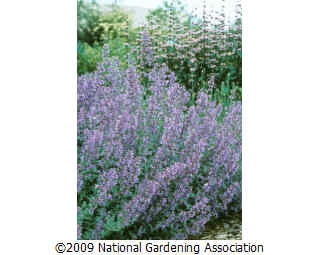Catmint

Related to catnip, but much showier, catmints (Nepeta) are easy to grow perennials that not only have flowers in shades of purple-blue, pink and white, but gray-green foliage that remains attractive throughout the growing season as well.
About This Plant
The most familiar catmints are those with purple-blue flowers that bloom heavily in early summer. These come in a range of heights, from a foot tall up to as much as 3-4 feet tall, making them useful in many garden settings, including flower borders, rock gardens, and edging. A classic combination is to grow them with hybrid tea roses to cover the "bare knees" of the rose bushes and complement the many shades of rose blossoms with their soft blue flowers.
But there are also catmints with pale pink or white flowers, even one uncommon species with yellow flowers. All make great bee and butterfly attracting plants. Most are hardy in zones 3-8.
Special Features
Faassen's catmint (Nepeta X faassenii) One of the most popular catmints, the flowers of this hybrid are sterile, so it doesn't need deadheading to prevent self-sowing. A number of cultivars of this species are widely available, including
'Blue Wonder', 1-2 feet tall, with dark blue flowers,
'Kit Kat', a long-blooming, 18 inch tall selection, and
'Walker's Low', with lavender-blue flowers on arching, 2-3 tall stems.
'White Wonder' is a white flowered cultivar.
'Six Hills Giant' is among the tallest, with 9-12 inch spikes of deep purple flowers on 3-4 foot tall plants.
Siberian catmint (Nepeta sibirica) is a tall (2-3 feet), upright growing plant with larger, greener leaves than Faassen's catmint and rich blue flowers in a whorled cluster that bloom over a long period.
Japanese catmint (Nepeta subsessilis) Unlike many catmints, this one prefers moist soils. One of the most commonly offered cultivars is
'Candy Cat', with dense clusters of pale, lavender-pink flowers on a 2 foot high plant.
Yellow Catnip (Nepeta govaniana) Native to the Himalayas, this unusual and hard-to-find catmint bears yellow flowers in small, loose clusters in mid to late summer.
Site Selection
Most catmints prefer full sun and well-drained, not overly fertile soil, although plants in hot summer areas do well with some afternoon shade. Established plants are quite drought tolerant.
Planting Instructions
Container grown plants can be set out throughout the growing season. Space smaller cultivars 18-24 inches apart; taller varieties should be set about 30 inches apart. Prepare the garden bed by using a garden fork or tiller to loosen the soil to a depth of 12 to 15 inches, then mix in a 2- to 4-inch layer of compost. Dig a hole twice the diameter of the pot the plant is in. Carefully remove the plant from its container and place it in the hole so the top of the root ball is level with the soil surface. Carefully fill in around the root ball and firm the soil gently. Water thoroughly.
Care
Shear back plants by one-third after their first flush of bloom is past to neaten plants and encourage a second flush of flowers later in the summer. Keep plants vigorous by dividing every 3-4 years in spring or early fall. Give newly set out or divided plants regular watering until established. While not as enticing to cats as true catnip, felines may still try to roll on catmints. If there are cats around, it's a good idea to protect young plants for a while with a dome made out of chicken wire. An annual layer of compost in fall or spring should provide catmint with all the nutrients it needs.






 Related to catnip, but much showier, catmints (Nepeta) are easy to grow perennials that not only have flowers in shades of purple-blue, pink and white, but gray-green foliage that remains attractive throughout the growing season as well.
Related to catnip, but much showier, catmints (Nepeta) are easy to grow perennials that not only have flowers in shades of purple-blue, pink and white, but gray-green foliage that remains attractive throughout the growing season as well.